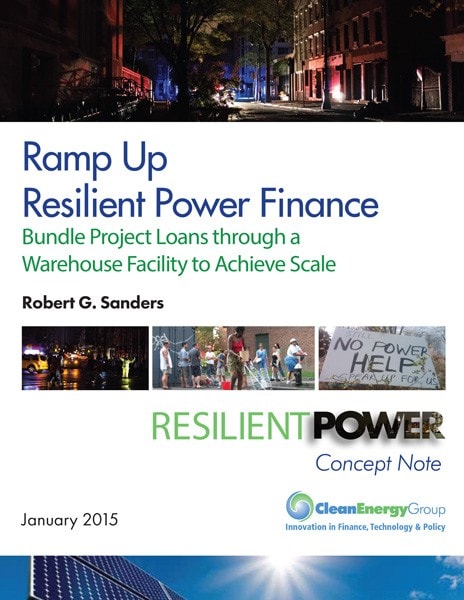January 28, 2015
Financing Clean Energy for Climate Adaptation
By Robert Sanders

This report, Ramp Up Resilient Power Finance: Bundle Project Loans Through a Warehouse Facility to Achieve Scale, explores using this proven loan bundling approach to finance resilient power projects across the country, to move from financing of single projects to financing of many projects in a loan portfolio. The warehouse credit facility model has been used for other commercial and consumer loan obligations, such as mortgage lending, for decades. But it has not yet been used for these kind of clean energy infrastructure projects. This paper explains how this finance tool can be used develop community-scale “resilient power” projects that will keep the power on when the grid goes down.
Resilient power, sometimes called “energy assurance,” is the ability to provide needed power, independent of the grid. Our electric grids are vulnerable to storms, tornadoes, wildfires and other disasters. The elderly as well as disabled and low-income populations are particularly vulnerable to the effects of power outages, as are critical facilities such as hospitals, policy stations and emergency shelters. The ability to generate electricity to power critical facilities and infrastructure during power outages from the grid is paramount in emergency planning.
A broad range of resilient power projects have been developed to date, from small residential energy storage systems to multi-megawatt grid scale storage projects. But all have one feature in common: they are financed on a one-off basis.
If integrated clean energy plus storage technologies are to develop to scale, then a new financing framework will need to be built to finance multiple, aggregated, resilient power projects. This is especially important for what could be called climate adaptation projects—the new infrastructure communities must install to protect against severe weather events, which includes access to reliable electric power. We will need this infrastructure all over the country, and a top priority is to figure out how to finance it.
In addition to proposing the warehouse credit facility model as a viable financing method, Clean Energy Group calls for a broader conversation about creating durable models of climate and clean energy finance. The report raises some key questions market players like states, communities, and developers need to address on how to finance resilient power projects at scale:
- Can we develop a more robust financing strategy to aggregate resilient power projects to get to scale?
- Can the existing green banks or similar financing entities in states work toward together to create a warehouse credit facility to aggregate pipelines of resilient power financings?
- Can a warehouse credit facility be used to provide liquidity for both large resilient power projects (waste water treatment facilities, utility-owned micro-grids) and for smaller community resilient power facilities (multifamily affordable housing and assisted living facilities, emergency shelters, police and fire services, dialysis and community health centers, publicly-owned buildings.)?
- What market segments of resilient power projects are likely to yield sufficient pipelines of projects to result in a marketable security? Is there an opportunity to roll up similarly structured transactions from multiple jurisdictions and across state lines to increase the size of the ultimate security?
The paper suggests that these questions can be answered in the affirmative, and we are on the cusp of developing new finance tools for community-scale, resilient power infrastructure.














